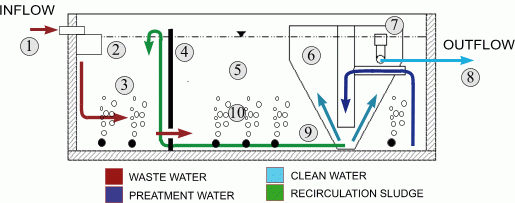Packed Wastewater Treatment Plants
Purpose
Packed series is another type of ADOS wastewater treatment plants. New series utilises up-to-date knowledge of the wastewater treatment field and experience of practice got from several year active operation. These treatment plants are intended for treatment of small isolated sources of wastewater as e.g.: small townships, hotels in mountains, camps, motels, service stations, small factories.
Packed wastewater treatment plants (BC) are offered in capacities of 35, 50, 75, 100, 150, 200, 250, 300 to 450 Population Equivalent (PE). The capacity of a treatment plants can be modified by requirements. Treatment plants of higher capacity can be supplied for big sources of wastewater.
Description of Design
The bioreactor is a vessel partitioned into several interdependent zones hydraulically interconnected. These zones include mechanical debris collection, sand traps, de-nitrification, nitrification and final sedimentation zones.
Legend:
1. Inflow, 2. Debris trap or screen, 3. Denitrification zone, 4. Baffle plate, 5. Nitrification (activation) zone, 6. Sedimentation zone, 7. Effluent trough, 8. Outflow, 9. Sludge return, 10. Aeration system
Wastewater is first screened to remove larger mechanical impurities by means of debris traps for small plants and by screens mechanically or manually cleaned for bigger plants. Then mechanically screened wastewater enters a denitrification zone where, when mixed with return activated sludge, the first treating processes in wastewater start. Then wastewater under treatment with return activated sludge flows on to nitrification zone – aerated. Other treating processes continue to remove contaminating materials from wastewater. Clear water is separated from activated sludge in the final sedimentation zone USBF. Water flows out and sludge returns back to the system.
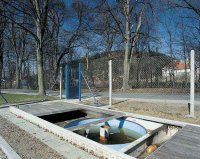
WWTP 120 PE
|
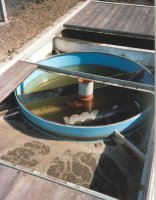
WWTP 120 PE
|
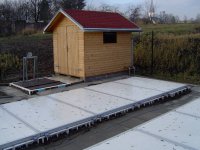
WWTP 200 PE
|
Wastewater treatment plants of 300 PE capacities are supplied as ready-made products – plastic or rust-restanant steel tanks with built-in technology, those of greater capacities are supplied as plant constructions with the technology to be installed.
On reconstructing wastewater treatment plants the existing tanks are resued and the plant auxiliary facilities are modernised, if need be.On treating industrial wastewater an aeration tank project is tailored to size and a degree of chemical pretreatment is proposed, if need be (wastewater of textile industry, ….).
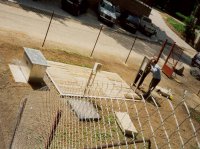
WWTP 75 PE
|
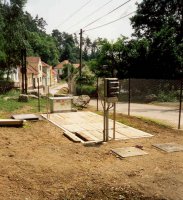
WWTP 75 PE
|
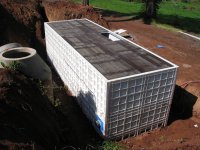
WWTP 100 PE
|
Structural Drawing BC 100
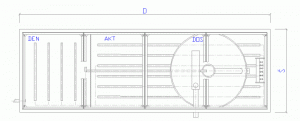
Plan WWTP
|
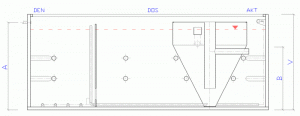
Cross-section WWTP
|
| Packed WWTP | BC 35 | BC 50 | BC 75 | BC 100 | |||
| Population to server up | PE | 35 | 50 | 75 | 100 | ||
| Load BOD | kg/den | 2,1 | 3 | 4,5 | 6 | ||
| Wastewater amount | m3/den | 7 | 10 | 15 | 20 | ||
| Power input | kW | 0,55 | 0,55 | 1,1 | 1,5 | ||
| Gross weight | kg | 850 | 1000 | 1200 | 1500 | ||
| Height of inflow A | m | 1,8 | 2,3 | 2,3 | 2,3 | ||
| Height of outflow B | m | 1,3 | 1,7 | 1,7 | 1,7 | ||
| Tank dimension DxSxV | m | 4x2,16x2,08 | 4x2,16x2,58 | 5x2,16x2,58 | 6,5x2,16x2,58 | ||
| Number of tanks | pcs | 1 | 1 | 1 | 1 | ||
Layout in location
The general scheme of using BC ADOS for wastewater treatment built-up areas.
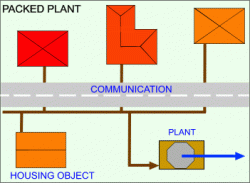
Schema WWTP BC
|




